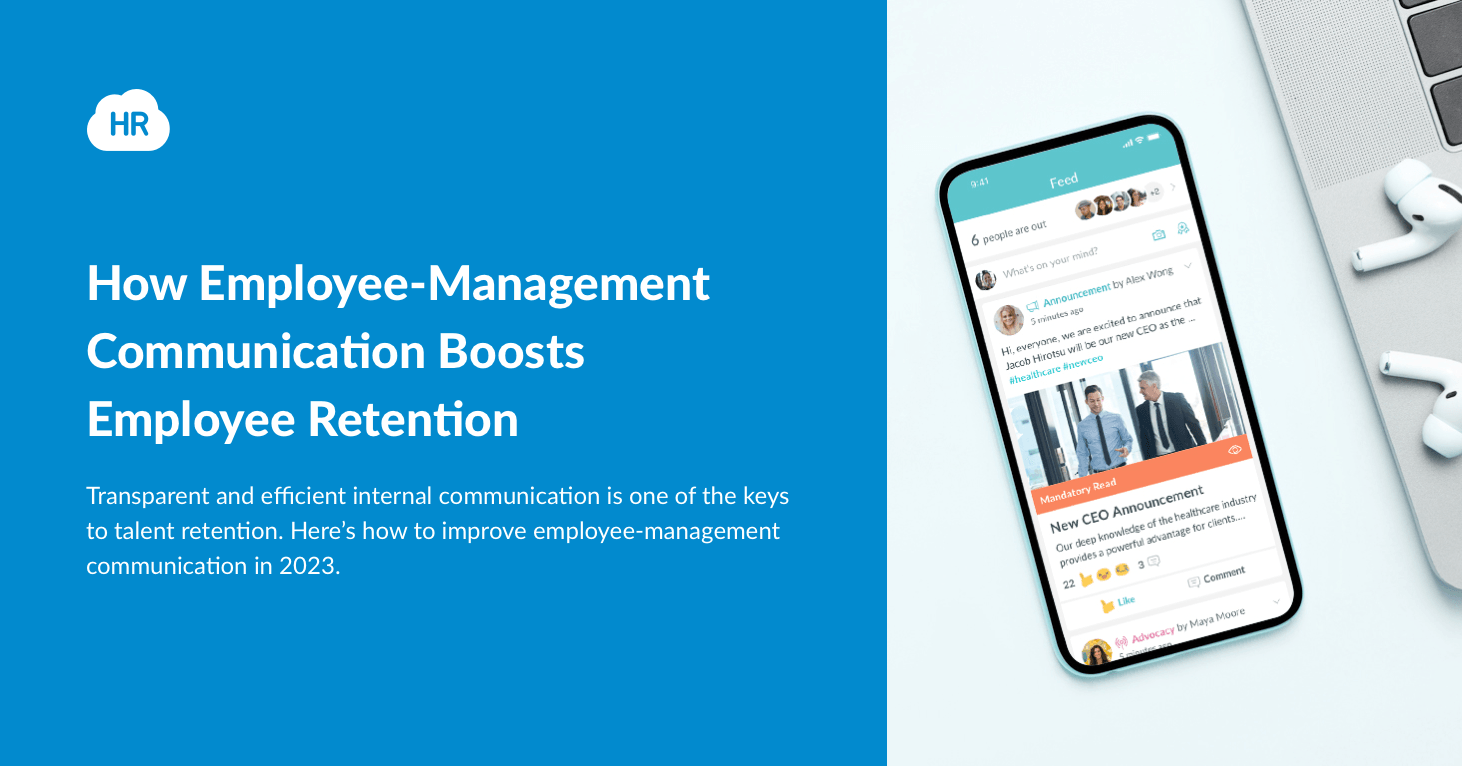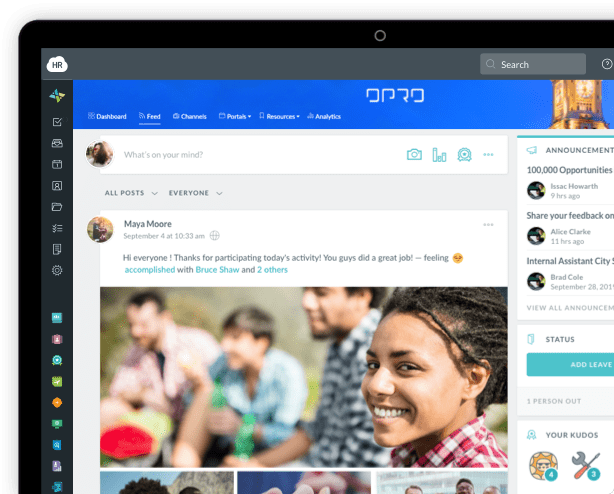How Employee-Management Communication Boosts Employee Retention

- Importance of employee retention in 2023
- 7 Ways to Boost Retention through Employee–Management Communication
- Gather data to know how to communicate
- Improving two-way communication
- Talking about money
- Communication for new hires
- Maximizing the employee lifetime value (ELTV)
- Understanding their needs and communicating value
- Use the right tools for effective communication
- Over to you
Job hopping, the gig economy, talent shortages, and competitors offering bigger and better opportunities to talented job-seekers — all of this has created a bit of a crisis for businesses in competitive industries. Today’s talent are no longer afraid to actively change jobs until they find the right fit, making talent retention a big challenge.
This is, of course, a positive change, as it keeps the job market competitive, but it also ensures that the talent stays in charge of the narrative. Businesses are no longer able to undercut or underpay employees without repercussions, and business leaders are realizing that casual Fridays or impromptu pizza parties are not enough to keep employees happy.
No, modern employees deserve more, and if you are reading this, you realize the importance of investing in your employee collective, their success, and their mental health. That’s why today we are talking about the importance of talent retention, and how good employee–management communication can help keep the best of the best at your side in 2023.
Importance of employee retention in 2023
Before we get into the concrete communication tips, tools, and strategies you can use to boost retention in your company, let’s address one important question first: Why should you invest in employee–management communication? Furthermore, why does employee retention matter so much moving forward?
The short answer is that employee retention is one of the best if not only ways to keep your company moving continuously forward, while constant acquisition and turnover will disrupt your operation. But there’s a little more to it.
Talent shortages
If you haven’t experienced the burdens of talent shortages, consider yourself lucky for now. In 2022, 75% of companies globally report talent shortages, a number which is expected to rise in the years to come.
Good workers and experts on all levels of the corporate hierarchy are difficult to find nowadays, especially in competitive industries, making talent retention even more important than before.
The dangers of global hiring
The post-pandemic remote work era is well underway, and global hiring has become commonplace. Suddenly, talented employees have even more job opportunities at their disposal, with companies fighting over the best of them.
With lucrative offers now coming in from all over the world, you can rest assured that snatching one of your top employees right from under your nose is easier than ever before.
The cost of talent acquisition
Another big problem business leaders face is the increasing cost of talent acquisition. Retaining top talent will always be more budget-friendly than prospecting, hiring, onboarding and training, and investing in new hires.
This problem alone should be enough to incentivize you to invest in talent retention in 2023.

7 Ways to Boost Retention through Employee–Management Communication
-
Gather data to know how to communicate
First things first, it’s important to note that every organization will have a different approach to communication when it comes to channels, communication hierarchy and structure, communication culture, and most importantly, the needs of the employees. If you want to nurture a culture of open and transparent communication, then you have to know what motivates your employees and what they care about.
This is not something you can just guess, nor is it something you can find out with one survey. Rather, learning what motivates your employees is a process that evolves throughout the year. Pulse surveys provide a great way to gather the right data. They allow you to keep your hand on the “pulse” of your organization and continuously derive useful data throughout the year.
A pulse survey is a brief set of questions that address a very specific topic that you can send to employees on a regular basis. Instead of sending out one giant survey, a short pulse survey ensures that your communication is on point and that you can adjust your communication strategy on the go if necessary. Workmates offers an amazing pulse survey feature to find out everything you need to know to keep your employees happy.
-
Improving two-way communication
When we say employee–management communication, we don’t just mean the way employees talk to managers — we’re talking about the two-way communication that builds relationships and a productive culture. The key to effective communication is to let the HR professionals in your organization educate and train both sides.
Managers should know exactly how to give constructive feedback and how to talk to every employee, while the employee should know how to communicate diplomatically with the higher-ups to get their points across without stepping on any toes. This is a delicate balance that, when maintained, will make the employees feel appreciated for their hard work while accepting constructive feedback that will help them do their jobs better.
On the other hand, improving two-way communication will be crucial for managers. Higher-ups are notoriously apprehensive when it comes to accepting feedback or criticism of any kind, but it is nonetheless essential for the future of the company.

-
Talking about money
There are many potential taboos or topics that you simply don’t discuss in your organization, and one of your key goals for 2023 should be to eliminate as many of these as possible. Open, transparent, and most importantly beneficial communication cannot happen if people are afraid to talk about something or if they think that certain topics are frowned upon in your organization. Not to mention that this doesn’t do your employer brand any favors in the eyes of the broader public.
Breaking common taboos should be a big part of your employee retention strategy, with an emphasis on destigmatizing money talk. Money is one of the most important topics for any employee, and pay equity is a burning issue.
If you don’t talk about money in your organization, or if you try to hide salaries or persuade people to keep quiet about their earnings, you will invariably hurt your brand’s reputation and trust.
-
Communication for new hires
While retention is your number one priority, you are of course going to acquire new talent over time as your business continues to grow and scale upwards. When new hires arrive, you naturally want to turn them into productive team members as quickly as possible — and you can only do that through efficient and effective communication.
New hires can have a difficult time settling in and getting to work in a new work environment, no matter how skilled, experienced, or talented they are. You need to make them feel welcome in your collective and help them break the ice with your veteran employees.
Be sure to share with them some icebreaker questions along with various conversation starters as a part of your digital welcome package, giving them some snippets on what the other employees are like. Give your existing talent a heads up about the new hires and encourage them to approach them with these icebreakers as well.
“Our staff has praised the increased communications level Workmates delivers. We use it to communicate important project matters and give staff specific ‘kudos’ or even recognize their birthdays. More importantly, we use Workmates to clarify important project details that needed rapid dissemination among the entire team.”

-
Maximizing the employee lifetime value (ELTV)
Employee lifetime value (ELTV) is a measurement of the value each employee brings to the company from the moment they start contributing to your organization to the moment they leave. To help your employees bring more value to the company, you can turn to a few highly impactful strategies, from how you handle the onboarding process to regular evaluations.
To start with, one of the most effective ways to maximize ELTV is to foster a culture of internal hiring, supported by well-kept employee directories that can help you harness your people’s full potential.
Keeping track of each person’s skills and growing capabilities can help you spot when they might be a greater asset for a different team. Allowing people to qualify for different positions instead of just advancing within the same department can help elevate your culture and boost retention.
Shortening your onboarding is another way to boost ELTV for your team members. The less time they spend preparing for their new role, the sooner they’ll be able to start contributing to your organization. Therefore, it’s ideal to start refining your onboarding process to keep it short and effective.
-
Understanding their needs and communicating value
Most industries have been affected by rapidly increasing talent demand paired with a talent shortage. Yet, most competitive businesses fail to align their employee–management communication with their retention goals. Yes, you do need to offer a competitive salary, numerous perks and benefits, and flexibility (such as remote or hybrid collaboration). However, that is far from enough to get someone inspired to stay with your organization for the long haul.

HR mistakes impact your entire organization. Learn how to avoid the 12 most common mistakes with our free ebook.
Download nowEmpathy, ensuring work-life balance, and offering advanced training and education all play a role in boosting retention. To address the talent shortage specific to your industry, you need to be sure you have a strategy that elevates retention and gives talent numerous, strong reasons to apply for your open roles.
In addition to all of the listed ideas, fostering strong, transparent communication between employees and management means that you will be able to understand your team’s needs, address them in time, and inspire your employees to refer people to start working with your business, as well.
-
Use the right tools for effective communication
Finally, to empower true flexibility and help employees communicate among themselves, but also with their management, you need an intuitive business messenger app that has all the right features you need.
Providing your team with the right software and having simple communication guidelines available for everyone will foster a sense of openness. Giving people the means to share their ideas, concerns, and feedback is a surefire way to strengthen employee retention and help you attract top talent in the future.
Over to you
Employee retention is more important than ever before, now that remote work has opened up new opportunities for talented employees and global companies are desperate to win over the best to their side. Don’t risk losing your top talent in 2023. Instead, recognize the need to invest in them and their growth and in employee–management communication that will help nurture a culture of productivity, happiness, and success in your organization.
The 40 Best Thank You
Messages for Colleagues
building a positive and engaged culture at your company.

Author Bio:
This article is written by a marketing team member at HR Cloud. HR Cloud is a leading provider of proven HR solutions, including recruiting, onboarding, employee communications & engagement, and rewards & recognition. Our user-friendly software increases employee productivity, delivers time and cost savings, and minimizes compliance risk.
Keep Reading
Balancing Technology and the Human Touch in Employee Engagement
Companies are taking employee engagement very seriously because it is one of the ways of
Building Strong Teams: The Power of Team Bonding Exercises
Never overestimate the power of collaboration as a core element of effective team


